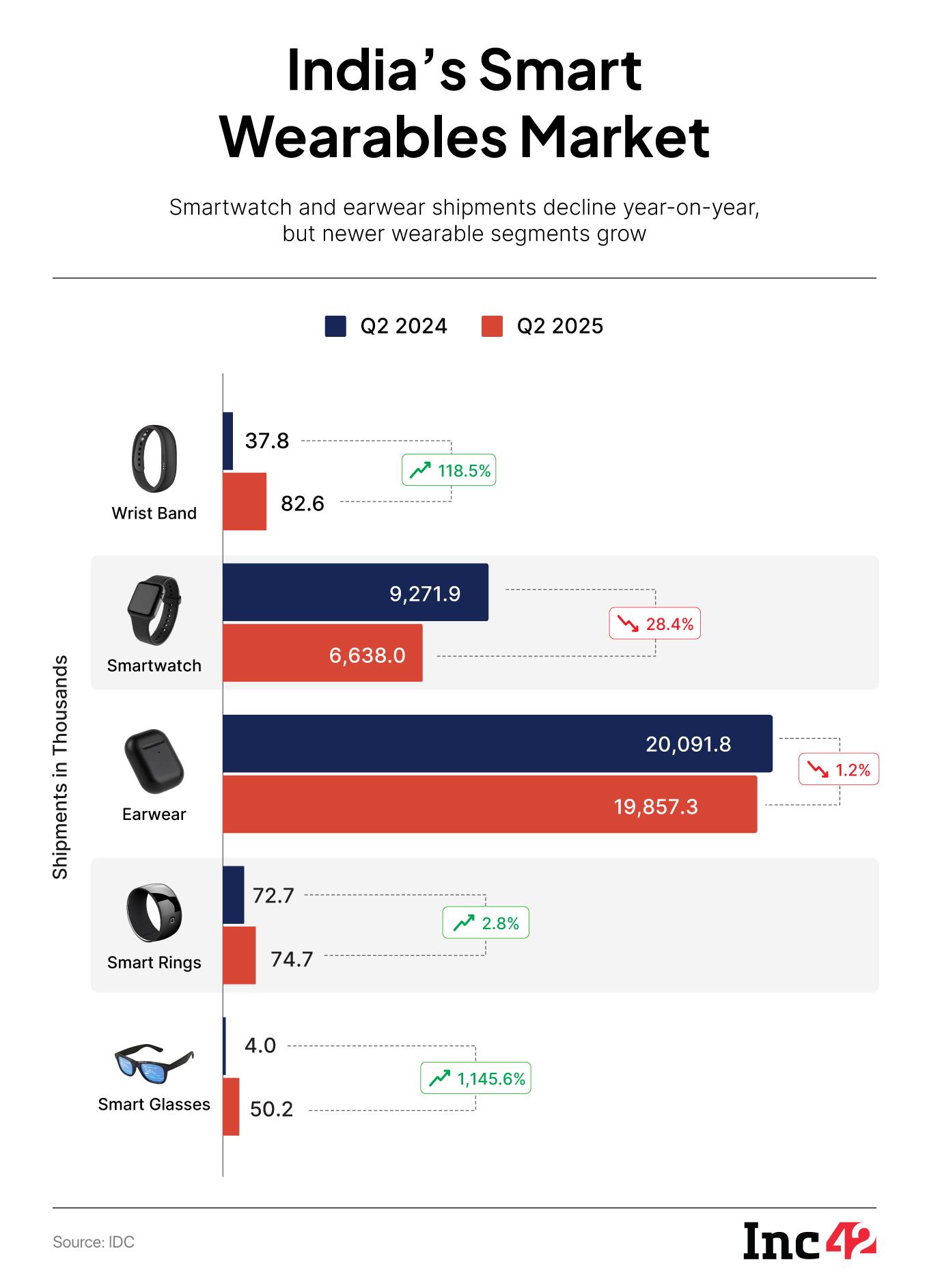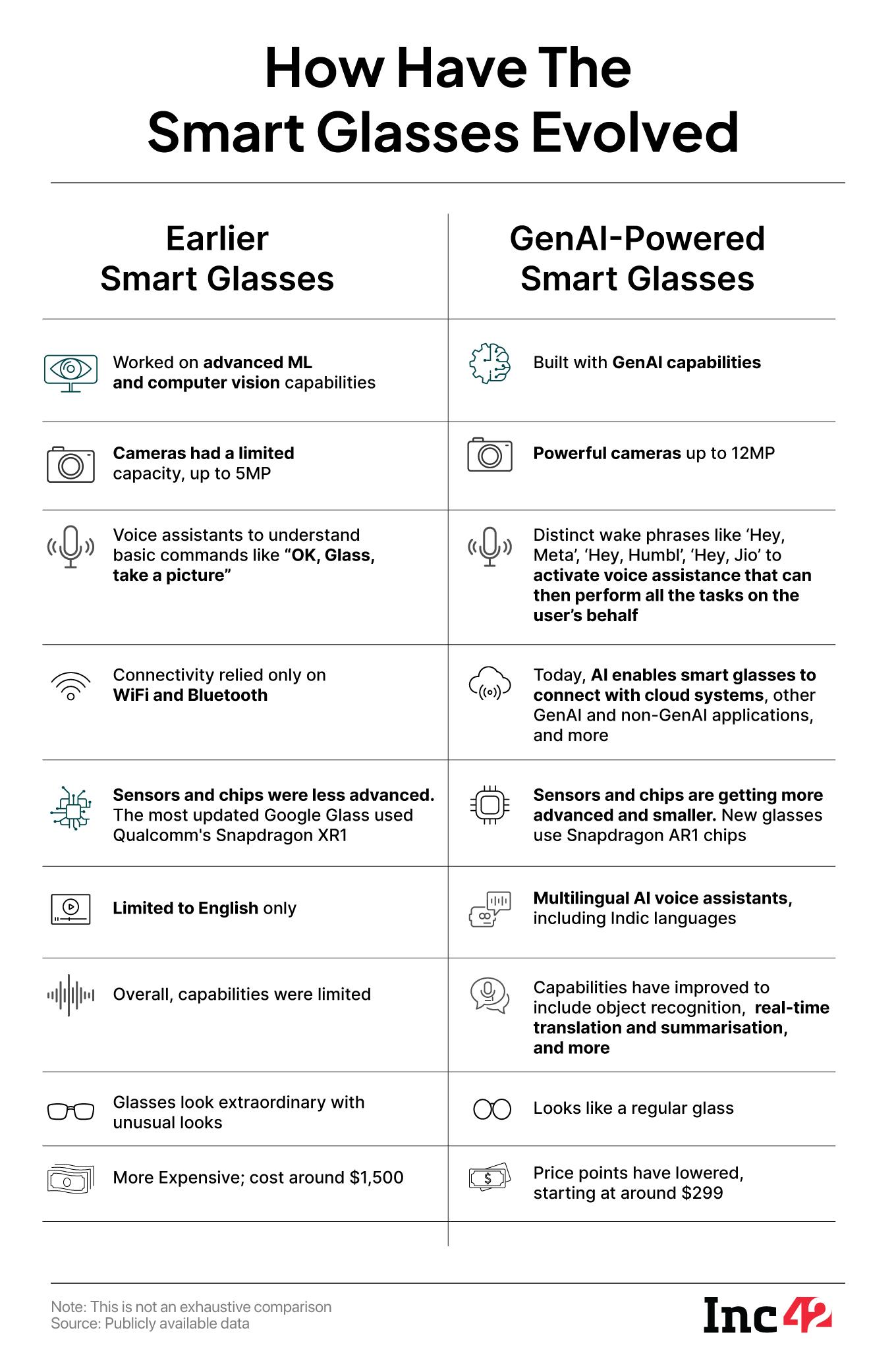Have you heard the whispers in the corridors of the tech sphere?
Smart glasses have turned smarter. In fact, they’re now powerful enough to soon outsmart the smartphone thanks to AI. At least that’s what is being claimed.
These devices have been around for more than a decade. Remember Google Glass? But, they have made a dramatic comeback in India in the past few months.
The whispers turned shouts with the field suddenly getting crowded. Reliance Jio is about to roll out Jio Frames, Lenskart has begun building AI eyewear with AjnaLens, and homegrown startup QWR is getting ready to unveil the country’s first indigenously developed AI smart glasses, Humbl, ahead of this festive season.
While these companies have been tinkering with the idea for a while and most have worked in the areas of VR (virtual reality) headsets, these launches follow the entry of Meta Ray-Ban smart glasses in India earlier this year, which sparked fresh interest in what was once considered a failed bet.
Google, which pioneered in this segment, could not scale its product worldwide, despite multiple attempts, due to high costs, hardware limitations, and privacy concerns.
However, there seems to be a potential shift in the trend globally. AI smart glasses reportedly accounted for 78% of total global shipments in the first half of 2025, up from 46% a year back, primarily driven by Meta Ray-Ban AI Glasses.
An IDC report showed that despite a slowdown in smartwatch and earwear segments in the second half of 2025, smart glass shipments shot off more than 1,000% over the last year.

So, what brought in clarity in the once foggy fate of these new IoT devices? It’s the rise of generative AI (GenAI).
With AI, The Lens Tells A Lot MoreThe raging wave of AI-powered smart glasses has gone beyond Meta, sweeping through large parts of the tech landscape, with the likes of Alibaba and Xiaomi launching their AI glasses, Google returning to the lab to develop a new-generation device, and Apple warming up to enter the ring next year. Even chip giant Qualcomm has doubled down on XR (extended reality) with its Snapdragon AR1+ Gen 1 processor.
The momentum is unmistakable. Experts believe that GenAI is reshaping the software story in these glasses, helping re-imagine the hardware aspect, as well.
“Until recently, smart glasses struggled with limited use cases and bulky hardware. The arrival of GenAI has changed that paradigm. Users can now interact with the world through an ‘informed lens’, with real-time contextual guidance, translations, health nudges, and productivity prompts,” said Abhishek Tandon, senior engagement manager at RedSeer.
Ray-Ban Meta glasses, for instance, are equipped with the Meta AI service that combines visual, audio, and other sensor data to provide a more comprehensive understanding of the user’s environment. They wake up as you say, Hey Meta. It allows the user to complete tasks like making phone calls, clicking pictures, getting information on various topics, playing music, and more, with just voice instructions – all without a smartphone. Meta AI can also record and send voice messages across Meta’s messaging platforms WhatsApp and Messenger.
Suraj Aiyar, who founded QWR, said that users can leverage AI-powered smart glasses to accomplish about 35% of the work they do on smartphones. “It is a unified form factor after watches and rings that can be widely adopted as daily wear without any kind of stigma attached to them.”
The makers are also carrying out various feature experiments with AI while keeping some basic specifications similar. Like Ray-Ban smart glasses, QWR has also built its glasses with a multimodal framework, an AI-based visual large model, seven speech algorithms, and more. It also has a wake phrase, Hey Humbl, to initiate conversation.
Unlike the Ray-Ban smart glasses, which can interact in English, Spanish and Italian, Humbl’s voice models are trained to interact in Indic languages like Gujarati, Bengali, Hindi, and Tamil to start with. In a major differentiator, the devices can interact with any AI assistant, from ChatGPT and Gemini to Grok and Perplexity, the company claimed.
While Jio is yet to disclose the exact language its smart glasses will have, the company has announced that its AI voice assistant supports multiple Indian languages. All photos and recorded videos clicked by the glasses can be instantly stored in the Jio AI Cloud, and the glasses will have the capability to provide summary or explanation of texts when a user is reading books.
But these are just the basic ones. The companies are building these devices with far smarter capabilities to create a brand-new wearable.

The AI-powered smart glasses are deceptive. They have the look-and-feel of the ubiquitous non-smart glasses, unlike the earlier Google Glass. They don’t appear something out of the ordinary, yet can be stylish, context-aware, smarter, and hands-free assistants that promise to blend seamlessly into everyday life.
These new-gen devices are lighter and more compact that can be carried throughout the day and their artificially intelligent assistants, which are being groomed to be more capable and flexible than clunky voice helpers like Siri, are set to be the central to all these personal computing devices, trumping smartphone software.
Meta Ray-Ban’s second-generation smart Wayfarers weigh around 50 grams, which is only five grams heavier than the regular Ray-Ban Wayfarers. QWR’s upcoming Humbl glasses would weigh 12 grams less than the Meta glasses. Both the devices use Qualcomm’s Snapdragon AR1, which is also the most widely used in this market.
Now, the chips too are getting smaller. Qualcomm’s AR1+ chips are 26% smaller than its last generation predecessor, yet claim to deliver superior image quality, power improvement, and the ability to run small language models (SLMs).
But, will it be a blockbuster? Adoption remains a big question.
Can Mass Market Adopt A Luxury Item?The market for AI-powered smart glasses is very nascent and the price points are still too high. The Ray-Ban smart glasses start at INR 30,000 in India, which is three times the price of regular wayfarers from the brand.
While Jio and QWR are yet to disclose their product prices, they are expected to be in a range considered luxury.
So, the question arises, does the Indian market have an appetite for these wearables?
According to RedSeer’s Tandon, the first opportunity comes with consumers who are using smartwatches and fitness trackers. “This cohort has both the spending power and the appetite for experimentation. For younger, fitness-conscious demographics, AI-enabled glasses could become wellness companions, reminding users to follow schedules, offering personalised micro-coaching, and extending adherence to health plans. Add to this lifestyle enhancements like payments-on-the-go and hands-free content capture,” he said.
He also pointed out that smart wearables are used by less than 10% of the Indian population and, in that, smartwatches and hearables have a lead. This represents a large headroom for smart glass companies to tap into the B2C market.
The larger opportunity, though, lies in B2B engagements across education, last-mile logistics, healthcare, insurance, sales, lifestyle and content creation.
With the GenAI capabilities, the smart glass adoption may see an uptick in note-taking assistance, speech-to-text support for hearing-impaired students, and immersive learning aids. Even in healthcare, people can benefit from personalised nudges that improve treatment adherence and chronic disease monitoring.
QWR’s Aiyar sees potential even in ride-hailing companies that want to equip their drivers with these smart glasses to run better behaviour analysis and enable more seamless interaction.
“We are also speaking to startups that are trying to build assistive glasses for the blind and insurance companies that want to give smart glasses to the agents who are out in the field doing assessment of cars or other things for better assessment,” Aiyar said.
He also hopes for the day when UPI payments could also be done hands-free through the smart glasses.
Though India’s growth story is different from that of the other parts of the world, the country has captured the market early this time and is expected to grow in sync with the global market that may see up to 90 Mn pairs sold by 2030 from about 1.5 Mn pairs sold last year.
Privacy, however, remains a key cause for concern. In absence of robust AI regulations even in the DPDP Act and with increasing cases of privacy and cybersecurity breaches along with deepfake incidents, the market still lacks clarity on how smart glasses would further complicate the scenario.
Hardware And Regulatory ConundrumImagine standing in front of someone wearing a smart glass, or your doorstep delivery person is looking at you through a smart glass. In such everyday situations, you can’t really tell if you’re being recorded, if your conversation is being transcribed, or if your image is being processed by an AI system.
That ambiguity is exactly where privacy concerns around smart glasses arise.
Unlike smartphones, where such trespassing is largely detectable while in use, smart glasses blur the line between passive wear and active surveillance. Uncomfortable questions about consent, data collection and trust in public and private spaces had earlier derailed Google Glass.
But, with GenAI making the smart glasses smarter and more seamless, the concern only accentuates, putting up a barrier for these companies to reach the masses.
It’s not that the concerns are left unaddressed. Meta Ray-Ban clearly mentions in its privacy policy that when a user takes photos or records videos, the capture LED in the glasses lights up to alert the person being photographed.
Even QWR has equipped its smart glasses with a similar notification light. It might also enable edge-based face-blurring capability based on different use cases, such as food delivery. “The Qualcomm AR1 chip has edge-based computing that can blur out any other face that is being captured by the glasses,” Aiyar said.
“It’s not like people aren’t sneaking and taking pictures or videos of people with smartphones. That hasn’t stopped smartphones from becoming a trillion-dollar market. Now, when it comes to large enterprise customers, they are more paranoid than anybody else. So, my bet is that more than the consumer-led demand, enterprise-led solutions are going to drive the market.”
Although the video recording bit is addressed to a large extent, concerns with audio stayed on. For instance, Meta’s glasses store voice recordings automatically whenever the voice assistant is active, which has the potential to lead to multiple data security and privacy breaches.
While it goes without saying that the companies must take greater measures at the product level, that’s an ideal scenario, and this new IoT device once again calls for better policy intervention.
[Edited By Kumar Chatterjee]
The post GenAI Gives Smart Glasses New Hope, But Is The Indian Market Even Ready? appeared first on Inc42 Media.
You may also like

Are Indian minorities facing structural discrimination?

Parents warned viral baby clothing hack could cause rashes and serious illness

SC to deliver verdict on pleas challenging Waqf (Amendment) Act, 2025 today

'Some northern leaders ... ': DMK MP Kanimozhi's big attack on BJP MP Anurag Thakur's 'Hanuman' remark - watch

Palaniswami heads to Delhi amid AIADMK power struggle






